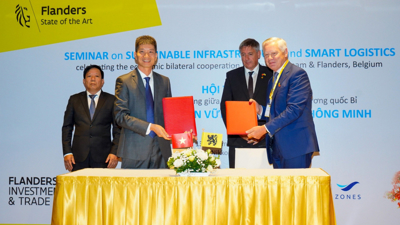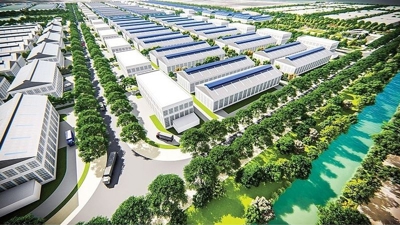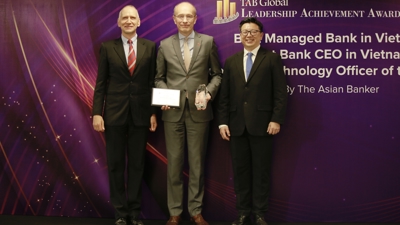Financial leasing encouraged for green growth
Mr. Nguyen Thieu Son, CEO of BIDV-SuMi TRUST Leasing (BSL), tells Vietnam Economic Times / VnEconomy how financial leasing, or asset leasing, can drive green growth and empower SMEs in Vietnam’s new development phase.

With the National Assembly setting an 8 per cent GDP growth target for 2025 and aiming for double-digit growth to 2030, what opportunities do you see for Vietnam’s financial leasing sector?
The 8 per cent growth target and the vision of double-digit growth in the 2026-2030 period reflect strong expectations for the private sector and for investments in business and production development. As a provider of medium and long-term capital, the financial leasing sector has significant opportunities to accompany the modernization of production and the digital transformation journey of enterprises, particularly small and medium-sized enterprises (SMEs).
We believe the financial leasing sector is facing three notable growth opportunities. First is the increasing demand among SMEs for new investments and the upgrading of machinery, equipment, and technology, especially since they often face challenges accessing traditional credit sources. Second is the growing trend towards sustainable development and ESG (environmental, social, and governance) standards, which are becoming increasingly important benchmarks for enterprise evaluation, thus requiring companies to innovate in technology and management. And third is the surge in demand for investment in infrastructure, construction equipment, and transport vehicles, as infrastructure development gains momentum.
Especially worth noting is that asset leasing is no longer limited to physical hardware. It can be expanded to digital assets, including hybrid assets that combine hardware with software and tech solutions. This evolution requires a more flexible legal framework that reflects the dynamics of the digital economy. If this opportunity is properly leveraged, the financial leasing sector can play a proactive role in supporting economic development in the country’s next stage of growth.
As of the end of 2024, total outstanding bank credit stood at nearly VND15,500 trillion ($596.15 billion) while the entire financial leasing sector contributed just over VND40 trillion ($1.54 billion), or about 0.26 per cent of total credit. Some experts see this as a major opportunity for the sector to grow its market share. What is your view?
Thanks to the efforts of the eight financial leasing companies currently operating in Vietnam, a number of businesses have become more familiar with and are increasingly using leasing products to effectively grow their operations. However, overall awareness among the broader business community about financial leasing remains limited.
The figure of 0.26 per cent of total outstanding credit partly reflects the reality that financial leasing has yet to develop in proportion to its potential and inherent characteristics. At the same time, this gap presents room for breakthroughs provided there is a well-defined strategy and an appropriate regulatory framework.
Current regulations governing financial leasing companies still apply many standards that closely resemble those imposed on commercial banks, including capital adequacy ratios, credit limits, risk management requirements, and non-performing loan (NPL) ratios. Therefore, what is needed now is to unlock financial leasing from the traditional bank-centered framework and reposition it as a specialized, flexible financial solution tailored to investment in equipment and technology.
In addition, policy needs to take the lead in creating momentum for market growth, from expanding tax incentives and refining the legal framework to diversifying funding channels beyond the banking system. At the same time, more effective communication is needed to help businesses, particularly SMEs, better understand the benefits of and how to access financial leasing services.
BIDV made a breakthrough decision in 2017 by forming a joint venture with Japan’s Sumitomo Mitsui Trust Bank (SMTB) to establish BIDV-SuMi TRUST Leasing (BSL). Could you tell us more about the operations of the joint venture?
BSL was established in 2017 with the aim of contributing to the prosperous and sustainable development of Vietnam’s economy and society by providing modern, transparent, and efficient financial leasing services.
The joint venture brings together the strengths of two leading financial institutions: BIDV, Vietnam’s largest bank and with an extensive nationwide network and deep understanding of the domestic market; and Sumitomo Mitsui Trust Bank, Japan’s largest trust bank, with more than 70 years of experience in financial leasing and strong risk management expertise.
The synergy between BIDV’s local reach and SMTB’s international experience enabled BSL to build a solid operational foundation from the outset, from governance and risk management to product development aligned with global best practices and well-suited to the Vietnamese market.
As of the end of 2024, BSL had financed equipment and machinery worth a cumulative total of more than VND17 trillion ($653.85 million) for over 1,300 businesses, maintaining an average annual growth rate of more than 30 per cent and rising to become one of the top 3 companies in the market with a market share of approximately 12 per cent.
In addition to scaling up, we have continuously strengthened our internal capabilities, from risk management and digital transformation to standardizing products in line with progressive practices, to enhance the customer experience. These efforts form the foundation for BSL to continue expanding partnerships and effectively supporting businesses in the years ahead.
The share of outstanding loans for industrial machinery leasing remains low across the sector. What is the situation at BSL, and what should be done to improve it given manufacturing’s role as a core economic driver?
It is true that within the sector’s overall credit portfolio, the share allocated to leasing production equipment remains relatively modest. However, at BSL, we have identified this as one of our core segments and have actively focused our resources on developing it. Currently, over 40 per cent of BSL’s outstanding loans are dedicated to financing machinery and equipment for production, primarily targeting SMEs.
To expand market share in this segment, I believe there must be a coordinated effort among various stakeholders, including government, regulatory agencies, financial leasing companies, and manufacturing businesses, based on a consistent and long-term strategic direction.
On the part of leasing companies, it is important to restructure product portfolios to be more diversified and prioritize capital allocation for core manufacturing sectors. At the same time, developing flexible product packages tailored to the operational characteristics and business cycles of different manufacturing industries will help increase capital efficiency and asset value. Additionally, establishing supply chain linkages with both domestic and international equipment providers can create a comprehensive ecosystem of solutions, from financing to after-sales services, thereby enhancing the competitiveness of businesses. In particular, investing in a team of experts with in-depth industry knowledge is crucial to improving the quality of credit assessment and funding decisions.
From the perspective of the government and the State Bank of Vietnam (SBV), a more open and stable legal framework for financial leasing is urgently needed. There should also be more effective mechanisms to support the handling of NPLs, asset recovery and disposal, and tax incentives, for example reducing VAT or corporate income tax on financial leasing transactions involving production equipment.
Finally, for manufacturing businesses, proactively accessing financial leasing as an alternative to traditional bank credit can help diversify capital sources and offer greater flexibility in fixed asset investment strategies. However, it is equally important that enterprises improve transparency and standardize financial reporting. This is key to enhancing access to funding from financial institutions. They also need clear, well-structured, and long-term business plans, along with proactive risk mitigation strategies to withstand market volatility.
The Vietnam Financial Leasing Association forecasts sector growth of 18-20 per cent this year, driven by transport, new technology production lines, and office equipment, with a strong focus on green credit to support sustainable business growth. What are BSL’s specific goals for 2025?
With a well-structured risk management system in place to ensure sustainable growth, BSL will continue improving operational efficiency, accelerating digital transformation, and expanding partnerships to contribute to the economy’s overall prosperity while accompanying customers on their sustainable development journey.
BSL is committed to quality and sustainable growth in 2025, focusing on three main directions. First, promoting green credit, second, developing leasing products for technology assets to meet the growing demand for technological upgrades, production automation, and digitalization, and third, continuing to invest in process improvements and product development to better meet customer needs and enhance the customer experience. In parallel, we are preparing for the next phase of brand positioning and business model innovation, laying a solid foundation for the company’s next stage of growth.







